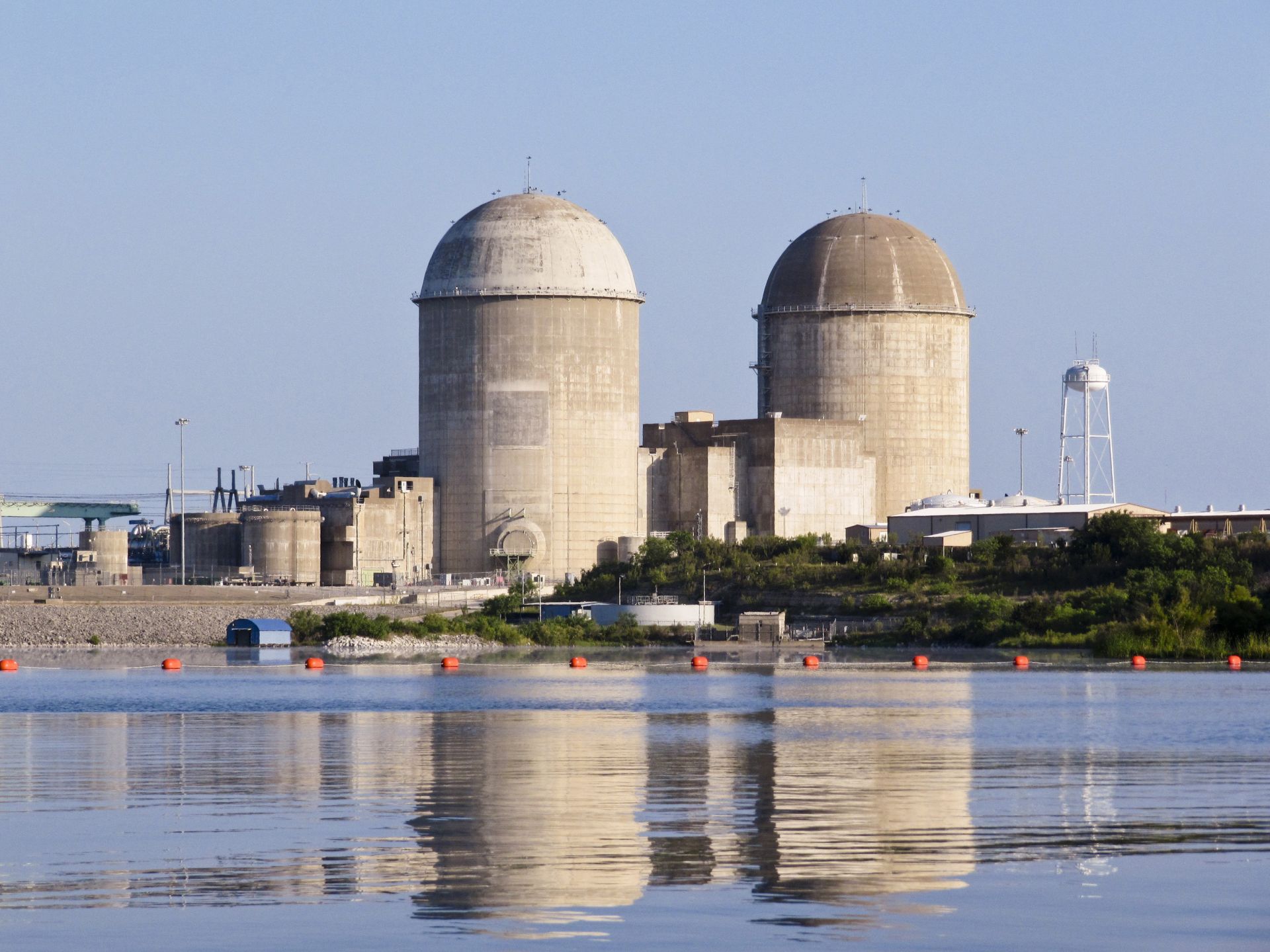Cameco headquarters in Saskatoon, Saskatchewan, Canada. (Photo: Cameco)
Five years after bankruptcy, Pennsylvania-based Westinghouse is being sold again, this time with a 49 percent share going to Cameco Corp., the front-end uranium mining, milling, and conversion company headquartered in Saskatchewan, Canada. Cameco and Brookfield Business Partners, based in Toronto, Ontario, announced the deal yesterday. Once it closes as expected, in the second half of 2023, Brookfield Renewable Partners and other Brookfield institutional partners will own a 51 percent interest in a consortium with Cameco.
The Trawsfynydd site in North Wales. (Photo: Magnox Ltd.)
The United Kingdom’s Nuclear Decommissioning Authority (NDA) has announced the signing of a memorandum of understanding with Cwmni Egino to support the development of a small-scale nuclear project in North Wales.
Turkey Point nuclear plant. (Image: FPL)
The Nuclear Regulatory Commission is seeking public comment on the scope of its supplemental environmental impact statement (SEIS) on the subsequent renewed licenses for Turkey Point-3 and -4, twin pressurized water reactors operated by Florida Power & Light (FPL). It’s the second time around for both the NRC and FPL—an SLR environmental scoping process conducted in 2018 already yielded renewed licenses for Turkey Point in December 2019. According to an October 7 NRC press release, “The staff intends to examine the environmental issues the commission determined were not properly evaluated for the subsequent license renewal term, as well as any new information for Turkey Point site–specific issues.”
Energy Harbor’s Beaver Valley plant, located on the Ohio River near Shippingport, Pa. (Photo: Energy Harbor)
Two critical factors for the success of nuclear industry outages are safety and efficiency. This includes personal and nuclear safety for the team members working on the outage, equipment safety through proper inspections and maintenance, and ultimately public safety when a reactor system is returned to service, free of defects and ready for reliable power production.
The Pickering nuclear power plant. (Photo: OPG)
The government of Ontario has announced its support for extending the operation of Ontario Power Generation’s Pickering nuclear plant for a year past its scheduled 2025 closure date, adding that a much longer extension is also being mulled.
OPG, at the government’s request, has reviewed its operational plans and concluded that the facility can continue to safely produce electricity for an additional year, according to a recent news release.
Aircraft line the runway at Eielson AFB in December 2020. (Photo: U.S. Air Force/Senior Airman Keith Holcomb)
The Department of the Air Force and the Defense Logistics Agency–Energy have released a request for proposals (RFP) for the construction and operation of a microreactor in central Alaska. The Department of Defense wants a 20-year supply of electricity and steam from a 1–5-MW microreactor, but the Eielson Air Force Base (AFB) Microreactor Pilot Program will go beyond a simple power purchase agreement and put the reactor through its paces with tests, at least annually, of the reactor’s walk-away safety and black-start capabilities. The final RFP is available at sam.gov.
Finland’s Olkiluoto-3. (Photo: TVO)
The Unit 3 EPR at Finland’s Olkiluoto nuclear power plant has reached its full capacity of approximately 1,600 MWe for the first time, plant owner and operator Teollisuuden Voima Oyj has announced. Olkiluoto-3 is now the most powerful reactor in Europe and the third most powerful globally, according to TVO. (Currently, the world champions in that department are China’s 1,660-MWe Taishan-1 and -2, also EPRs.)
Luminant’s two-unit Comanche Peak plant in Glen Rose, Texas. (Photo: Vistra Corporation)
Vistra Corporation announced yesterday that it is seeking 20-year life extensions for its Comanche Peak reactors and has submitted an application for license renewals to the Nuclear Regulatory Commission.
Operated by Vistra subsidiary Luminant and located in Glen Rose, Texas, Comanche Peak is home to two Westinghouse-supplied pressurized water reactors. The 1,218-MWe Unit 1 began commercial operation in August 1990, with the 1,207-MWe Unit 2 joining in August 1993. The original 40-year licenses for Units 1 and 2 expire in February 2030 and February 2033, respectively.
Germany’s Isar nuclear plant, located in Essenbach, Bavaria. (Photo: Elmschrat/WikiCommons)
With a reluctant bow to the reality of the energy crisis gripping Europe, the German government this week took a slight step back from its antinuclear power stance, forging an agreement with the operators of the Isar and Neckarwestheim plants to keep those facilities in “operational reserve” this winter should they be needed to ensure the country’s energy security.
ANS Standards Committee publishes new standard for light water reactor risk-informed, performance-based design
The new standard ANSI/ANS-30.3-2022, Light Water Reactor Risk-Informed, Performance-Based Design, has just been issued by the American Nuclear Society. Approved by the American National Standards Institute (ANSI) on July 21, 2022, the standard provides requirements for the incorporation of risk-informed, performance-based (RIPB) principles and methods into the nuclear safety design of commercial light water reactors. The process described in this standard establishes a minimum set of process requirements the designer must follow in order to meet the intent of this standard and appropriately combine deterministic, probabilistic, and performance-based methods during design development.
Belgium's Doel nuclear power plant. (Photo: N. Hippert/IAEA)
Unit 3 at the Doel nuclear power plant has become Belgium’s first reactor to be permanently shuttered, in keeping with that nation’s nuclear phaseout policy. The 1,006-MWe pressurized water reactor, which began commercial operation in October 1982, was removed from service last Friday at 9:31 p.m. (local time).
Belgium’s nuclear reactor fleet now consists of six operating units: Doel-1, -2, and -4 and Tihange-1, -2, and -3. Next on the retirement list is Tihange-2, scheduled to be shut down in February 2023.
The Estonian flag. (Image: WikiCommons)
Moving forward with its plan for small modular reactor deployment in Estonia, Fermi Energia has issued tenders to three SMR firms—GE Hitachi (GEH), NuScale Power, and Rolls-Royce, developers of the BWRX-300, NuScale Power Module, and Rolls-Royce SMR, respectively.
The Estevan region (Image: SaskPower)
As part of its planning and regulatory activities to potentially build small modular reactors (SMRs) in currently nuclear-powerless Saskatchewan, Canadian utility SaskPower has selected the province’s Estevan and Elbow regions for further study. (In 2018, SaskPower joined the Canadian government, three other provinces, and four other Canadian utilities to participate in the development of A Call to Action: A Canadian Roadmap for Small Modular Reactors.)













 The International Atomic Energy Agency, for the second successive year, has revised upward its annual projections of nuclear power’s potential growth over the coming decades as an electricity provider.
The International Atomic Energy Agency, for the second successive year, has revised upward its annual projections of nuclear power’s potential growth over the coming decades as an electricity provider.

